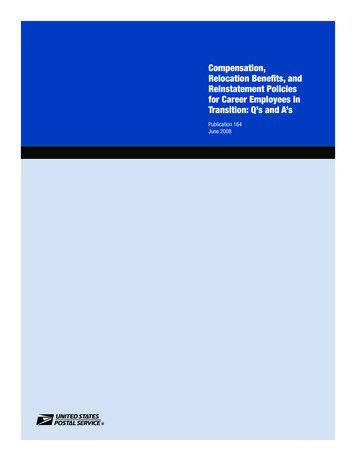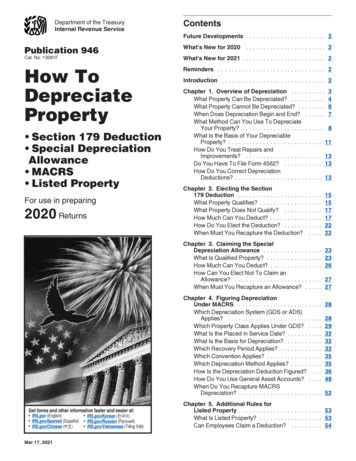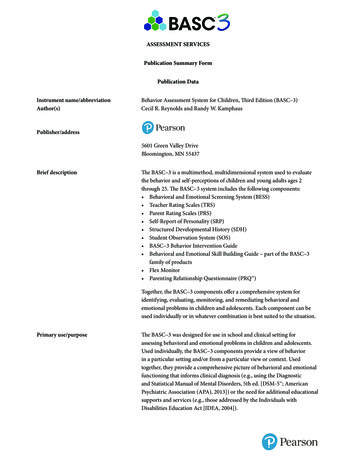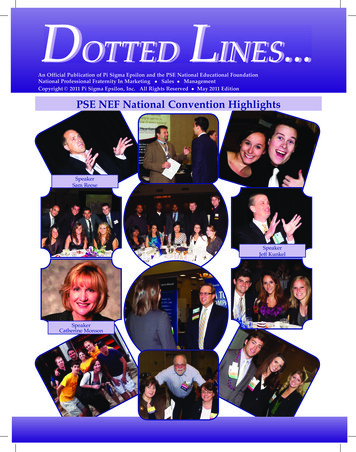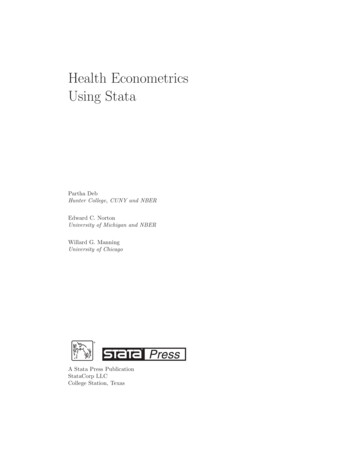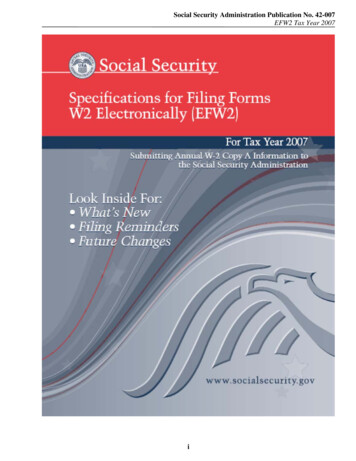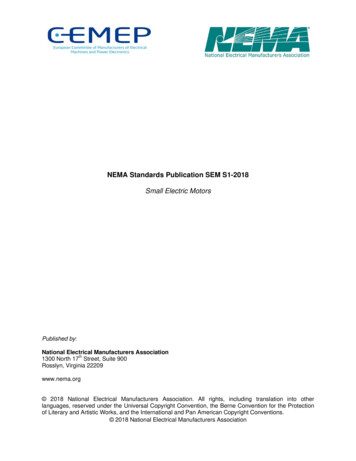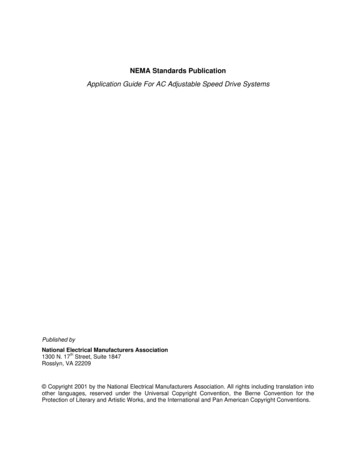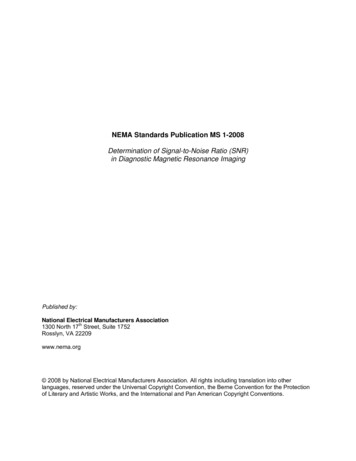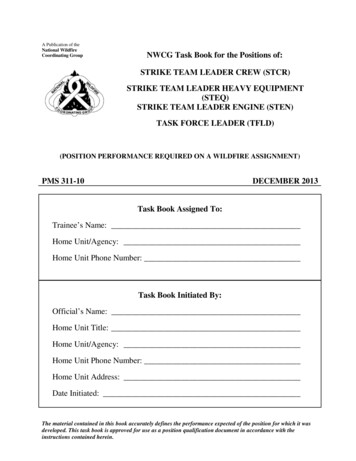
Transcription
A Publication of theNational WildfireCoordinating GroupNWCG Task Book for the Positions of:STRIKE TEAM LEADER CREW (STCR)STRIKE TEAM LEADER HEAVY EQUIPMENT(STEQ)STRIKE TEAM LEADER ENGINE (STEN)TASK FORCE LEADER (TFLD)(POSITION PERFORMANCE REQUIRED ON A WILDFIRE ASSIGNMENT)PMS 311-10DECEMBER 2013Task Book Assigned To:Trainee’s Name:Home Unit/Agency:Home Unit Phone Number:Task Book Initiated By:Official’s Name:Home Unit Title:Home Unit/Agency:Home Unit Phone Number:Home Unit Address:Date Initiated:The material contained in this book accurately defines the performance expected of the position for which it wasdeveloped. This task book is approved for use as a position qualification document in accordance with theinstructions contained herein.
Verification/Certification of Completed Task Bookfor the Position of:(position title)Final Evaluator’s VerificationTo be completed ONLY when you are recommending the trainee for certification.I verify that (trainee name) has successfullyperformed as a trainee by demonstrating all tasks for the position listed above and should beconsidered for certification in this position. All tasks are documented with appropriate initials.Final Evaluator’s Signature:Final Evaluator’s Printed Name:Home Unit Title:Home Unit/Agency:Home Unit Phone Number: Date:Agency CertificationI certify that (trainee name) has met allrequirements for qualification in the above position and that such qualification has been issued.Certifying Official’s Signature:Certifying Official’s Printed Name:Title:Home Unit/Agency:Home Unit Phone Number: Date:Additional copies of this publication are available through:NWCG, Publications Management System at ks2
NATIONAL WILDFIRE COORDINATING GROUP (NWCG)POSITION TASK BOOKNWCG Position Task Books (PTBs) have been developed for designated National InteragencyIncident Management System (NIIMS) positions. Each PTB lists the competencies, behaviorsand tasks required for successful performance in specific positions. Trainees must be observedcompleting all tasks and show knowledge and competency in their performance during thecompletion of this PTB.Trainees are evaluated during this process by qualified evaluators, and the trainee’s performanceis documented in the PTB for each task by the evaluator’s initials and date of completion. AnEvaluation Record will be completed by all evaluators documenting the trainee’s progress aftereach evaluation opportunity.Successful performance of all tasks, as observed and recorded by an evaluator, will result in arecommendation to the agency that the trainee be certified in that position. Evaluation andconfirmation of the trainee’s performance while completing all tasks may occur on one or moretraining assignments and may involve more than one evaluator during any opportunity.INCIDENT/EVENT CODINGEach task has a code associated with the type of training assignment where the task may becompleted. The codes are: O other, I incident, W wildfire, RX prescribed fire,W/RX wildfire OR prescribed fire and R rare event. The codes are defined as:O Task can be completed in any situation (classroom, simulation, daily job, incident,prescribed fire, etc.).I Task must be performed on an incident managed under the Incident CommandSystem (ICS). Examples include wildland fire, structural fire, oil spill, search andrescue, hazardous material, and an emergency or non-emergency (planned orunplanned) event.W Task must be performed on a wildfire incident.RX Task must be performed on a prescribed fire incident.W/RX Task must be performed on a wildfire OR prescribed fire incident.R Rare events such as accidents, injuries, vehicle or aircraft crashes occurinfrequently and opportunities to evaluate performance in a real setting are limited.The evaluator should determine, through interview, if the trainee would be able toperform the task in a real situation.While tasks can be performed in any situation, they must be evaluated on the specific type ofincident/event for which they are coded. For example, tasks coded W must be evaluated on awildfire; tasks coded RX must be evaluated on prescribed fire and so on. Performance of anytask on other than the designated assignment is not valid for qualification.3
Tasks within the PTB are numbered sequentially; however, the numbering does NOT indicatethe order in which the tasks need to be performed or evaluated.The bullets under each numbered task are examples or indicators of items or actions related tothe task. The purpose of the bullets is to assist the evaluator in evaluating the trainee; the bulletsare not all-inclusive. Evaluate and initial ONLY the numbered tasks. DO NOT evaluate andinitial each individual bullet.A more detailed description of this process and definitions of terms are included in theWildland Fire Qualification System Guide, PMS 310-1. This document can be found BILITIESThe responsibilities of the Home Unit/Agency, Trainee, Coach, Training Specialist, Evaluator,Final Evaluator and Certifying Official are identified in the Wildland Fire Qualification SystemGuide, PMS 310-1. It is incumbent upon each of these individuals to ensure their responsibilitiesare met.INSTRUCTIONS FOR THE POSITION TASK BOOK EVALUATION RECORDEvaluation Record #Each evaluator will need to complete an evaluation record. Each evaluation record should benumbered sequentially. Place this number at the top of the evaluation record page and also use itin the column labeled “Evaluation Record #” for each numbered task the trainee hassatisfactorily performed.Trainee InformationPrint the trainee’s name, position on the incident/event, home unit/agency, and the homeunit/agency address and phone number.Evaluator InformationPrint the Evaluator’s name, position on the incident/event, home unit/agency, and the homeunit/agency address and phone number.Incident/Event InformationIncident/Event Name: Print the incident/event name.Reference: Enter the incident code and/or fire code.Duration: Enter inclusive dates during which the trainee was evaluated.Incident Kind: Enter the kind of incident (wildfire, prescribed fire, search and rescue, flood,hurricane, etc.).Location: Enter the geographic area, agency, and state.Management Type or Prescribed Fire Complexity Level: Circle the ICS organization level(Type 5, Type 4, Type 3, Type 2, Type 1, Area Command) or the prescribed fire complexitylevel (Low, Moderate, High).4
Fire Behavior Prediction System (FBPS) Fuel Model Group: Circle the Fuel Model Groupletter that corresponds to the predominant fuel type in which the incident/event occurred.G Grass Group (includes FBPS Fuel Models 1 – 3):1 short grass (1 foot); 2 timber with grass understory; 3 tall grass (1½ - 2 feet)B Brush Group (includes FBPS Fuel Models 4 – 6):4 Chaparral (6 feet); 5 Brush (2 feet); 6 dormant brush/hardwood slash;7 Southern roughT Timber Group (includes FBPS Fuel Models 8 – 10)8 closed timber litter; 9 hardwood litter; 10 timber (with litter understory)S Slash Group (includes FBPS Fuel Models 11 – 13)11 light logging slash; 12 medium logging slash; 13 heavy logging slashEvaluator’s RecommendationFor 1 – 4, initial only one line as appropriate; this will allow for comparison with your initials inthe Qualifications Record.Record additional remarks/recommendations on an Individual Performance Evaluation, or byattaching an additional sheet to the evaluation record.Evaluator’s SignatureSign here to authenticate your recommendations.DateDocument the date the Evaluation Record is being completed.Evaluator’s Relevant Qualification (or agency certification)List your qualification or certification relevant to the trainee position you supervised.Note: Evaluators must be either qualified in the position being evaluated or supervise the trainee;Final Evaluators must be qualified in the trainee position they are evaluating.5
Common Tasks for STCR, STEQ, STEN, and TFLDThis task book contains tasks for the positions of Strike Team Leader (STL) and Task ForceLeader (TFLD). The common tasks for both positions are listed first. The tasks specific to the TaskForce Leader position are listed following the common tasks.Common TasksTFLD Specific Taskspages 6 – 16page 17(Tasks 1 – 44)(Tasks 45 – 48)STL PathwayThe common tasks only need to be completed once. Once qualified as a STL, any additional singleresource boss qualifications will allow agencies to qualify the individual in the corresponding STLposition. Certification must be documented on a Verification/Certification page.TFLD Pathways If the individual is qualified in only one STL position, to become a TFLD a Front CoverInitiation page and a Verification/Certification page must be printed and initiated and theTFLD specific tasks must be completed. For an individual utilizing the alternate pathway of Two Single Resource Boss ICT4, aTFLD PTB must be initiated and all tasks in the PTB must be accomplished and evaluated. For an individual utilizing the alternate pathway of any two Strike Team Leader positions,certification in any two STL positions (STCR, STEQ, STEN) will allow agencies to certifythe individual as a TFLD without completing the TFLD specific tasks in the PTB. However,certification as TFLD must be documented as certified on the Verification/Certificationpage of the TFLD PTB.Competency: Assume position responsibilities.Description: Successfully assume role of Strike Team Leader/Task Force Leader and initiate positionactivities at the appropriate time according to the following behaviors.TASKCODEEVAL.RECORD#EVALUATOR:Initial & dateupon completionof taskBehavior: Ensure readiness for assignment.O1. Gather and organize multiple resources for theassignment.Evaluate the numbered tasks ONLY. DO NOT evaluate bullets; they are provided as examples/additionalclarification.6
Common Tasks for STCR, STEQ, STEN, and TFLDBehavior: Ensure availability, qualifications, and capabilities of resources to completeassignment.2. Inspect assigned resources. Ensure qualifications of personnel. Ensure personal protective equipment (PPE). Establish and maintain personnel accountability. Ensure type(s) of equipment/tools and operatingcondition. Establish common communications and frequencycapability. Survey assigned resources for radio frequenciesand ID numbers.I3. Ensure assigned resources are within contractcompliance. Ensure Crew Boss and Squad Boss’s comply withEnglish language comprehension requirements. Ensure contract required tools, supplies, andcommunications are in compliance. Ensure Ground Support Unit Leader inspectsequipment when applicable. Ensure a copy of the resource’s contract isprovided to the Finance/Administration Section orlocal unit at check-in.O4. Request additional resources, logistical support, and/orreplacements through supervisors based on IncidentAction Plan (IAP), briefings, and discussions.IBehavior: Gather, update, and apply situational information relevant to the assignment.5. Report assigned resource status to agency dispatcher orsupervisor (include any units that fail to arrive or failreadiness inspection).I6. Brief assigned resources and determine route of travel,en route logistical needs (fuel, food, etc.). Determineproper formation, communications, and en routecheckpoints.I7. Obtain IAPs or other relevant plans.IEvaluate the numbered tasks ONLY. DO NOT evaluate bullets; they are provided as examples/additionalclarification.7
Common Tasks for STCR, STEQ, STEN, and TFLDTASKCODEEVAL.RECORD#EVALUATOR:Initial & dateupon completionof taskBehavior: Establish effective relationships with relevant personnel.8. Establish and maintain positive interpersonal andinteragency working relationships.IBehavior: Establish organization structure, reporting procedures, and chain of commandof assigned resources.9. Organize assigned resources into configurations whichwill meet incident/tactical objectives.IBehavior: Understand and comply with ICS concepts and principles.10. Develop the organization structure necessary to managethe incident. Maintain appropriate span of control.I11. Apply the ICS. Follow chain of command. Use appropriate ICS forms. Use appropriate ICS terminology.IEvaluate the numbered tasks ONLY. DO NOT evaluate bullets; they are provided as examples/additionalclarification.8
Common Tasks for STCR, STEQ, STEN, and TFLDCompetency: Lead assigned personnel.Description: Influence, guide, and direct assigned personnel to accomplish objectives and desiredoutcomes in a rapidly changing, high-risk environment.TASKCODEEVAL.RECORD#EVALUATOR:Initial & dateupon completionof taskBehavior: Model leadership values and principles.12. Exhibit principles of duty. Be proficient in your job, both technically and as aleader. Make sound and timely decisions. Ensure tasks are understood, supervised andaccomplished. Develop your subordinates for the future.I13. Exhibit principles of respect. Know your subordinates and look out for theirwell-being. Keep your subordinates informed. Build the team. Employ your subordinates in accordance with theircapabilities.I14. Exhibit principles of integrity. Know yourself and seek improvement. Seek responsibility and accept responsibility foryour actions. Set the example.IBehavior: Ensure the safety, welfare, and accountability of assigned personnel.15. Provide for the safety and welfare of assignedresources. Recognize, mitigate and communicate potentiallyhazardous situations. Monitor condition of assigned resources. Account for assigned resources. Provide for care of assigned resources and notifysupervisor in event of sickness, injury, or accident.I16. Ensure assigned resources are following safetyguidelines appropriately.IEvaluate the numbered tasks ONLY. DO NOT evaluate bullets; they are provided as examples/additionalclarification.9
Common Tasks for STCR, STEQ, STEN, and TFLDTASKCODE17. Demonstrate ability to coordinate and use multiplefrequencies.EVAL.RECORD#EVALUATOR:Initial & dateupon completionof taskOBehavior: Establish work assignments and performance expectations, monitorperformance, and provide feedback.18. Assign tasks to resources based on IAP or relevantoperational plans, division/group assignments, andresource capabilities.19. Determine and provide for assistance or corrections toassigned work task(s) during operational period. Contact supervisor to review tactical effectiveness. Identify need for additional assistance, logisticalsupport and replacements due to slow progress orunexpected events (e.g., types of resources). Evaluate recommendations from subordinatesupervisors (e.g., split assignment with anotherdivision). Identify need for alternative firing/ignition devicesand techniques.IW/RXBehavior: Emphasize teamwork.20. Establish cohesiveness among assigned resources. Provide for open communication. Seek commitment. Set expectations for accountability. Focus on the team result.IEvaluate the numbered tasks ONLY. DO NOT evaluate bullets; they are provided as examples/additionalclarification.10
Common Tasks for STCR, STEQ, STEN, and TFLDTASKCODEEVAL.RECORD#EVALUATOR:Initial & dateupon completionof taskBehavior: Coordinate interdependent activities.21. Establish communication with supervisors andadjoining resources.I22. Ensure transportation needs are met as specified in theIAP or relevant plans. Coordinate any additional transportation needsthrough Ground Support Unit. Inform supervisor if transportation needs cannot bemet. Ensure assigned resources arrive at assignmentlocation.I23. Coordinate activities with adjacent Strike TeamLeaders/Task Force Leaders and single resources. Contact adjoining resources. Make list of supervisors of adjoining resources. Inform adjoining resources of status. Receive status of adjoining resources. Determine communication channels with adjoiningresources from IAP or relevant plans. Maintain communication with assigned resources.IEvaluate the numbered tasks ONLY. DO NOT evaluate bullets; they are provided as examples/additionalclarification.11
Common Tasks for STCR, STEQ, STEN, and TFLDCompetency: Communicate effectively.Description: Use suitable communication techniques to share relevant information with appropriatepersonnel on a timely basis to accomplish objectives in a rapidly changing, high-risk environment.TASKCODEEVAL.RECORD#EVALUATOR:Initial & dateupon completionof taskBehavior: Ensure relevant information is exchanged during briefings and debriefings.24. Brief and keep subordinates informed and updated. Ensure expectations are communicated andunderstood.I25. Attend operational briefings and meetings as directed. Provide information as requested. Keep supervisor informed of issues and potentialproblems.I26. Brief assigned resources using information from IAP orrelevant plans. Planned objectives and supervisor controlassignments. Work standards and expectations. Weather Communication Expected fire behavior. Prescribed fire briefing checklist. Safety Message ICS 206, Medical PlanI27. Brief relief forces. Current status/conditions/concerns regardingassignment.I28. Establish contact or communication procedures forincident camp. Ensure resources arrive at camp at end of shift.I29. Debrief with supervisor after operational period. Provide updated status and location of assignedresources.IEvaluate the numbered tasks ONLY. DO NOT evaluate bullets; they are provided as examples/additionalclarification.12
Common Tasks for STCR, STEQ, STEN, and TFLDTASKCODE30. Participate in functional area briefings and conduct unitAfter Action Reviews (AARs).IEVAL.RECORD#EVALUATOR:Initial & dateupon completionof taskBehavior: Ensure documentation is complete and disposition is appropriate.31. Ensure ICS 214, Unit Logs are completed andsubmitted by assigned resources.O32. Authorize personnel and equipment time.IBehavior: Communicate and ensure understanding of work expectations within the chainof command and across functional areas.33. Ensure understanding of work expectations by multipleresources within the chain of command.IEvaluate the numbered tasks ONLY. DO NOT evaluate bullets; they are provided as examples/additionalclarification.13
Common Tasks for STCR, STEQ, STEN, and TFLDCompetency: Ensure completion of assigned actions to meet identifiedobjectives.Description: Identify, analyze, and apply relevant situational information and evaluate actions tocomplete assignments safely and meet identified objectives. Complete actions within :Initial & dateupon completionof taskBehavior: Gather, analyze, and validate information pertinent to the incident or event andmake recommendations for setting priorities.34. Monitor progress/work during operational period. Receive reports from subordinate supervisors. Conduct personal observations. Inspect and locate line in advance of lineconstruction. Assess values to be protected.IBehavior: Make appropriate decisions based on analysis of gathered information.35. Plan tactical action on assigned area based onobjectives, supervisor assignments, and fire behavior. Identify impacts of modified objectives on resourceassignments. Determine situations that might modify tactics.WBehavior: Take appropriate action based on assessed risks.36. Apply the Risk Management Process found in theIRPG and Fireline Handbook. Step 1: Situation Awareness Step 2: Hazard Assessment Step 3: Hazard Control Step 4: Decision Point Step 5: Evaluate37. Ensure assigned resources apply appropriate tactics forassignment.IWEvaluate the numbered tasks ONLY. DO NOT evaluate bullets; they are provided as examples/additionalclarification.14
Common Tasks for STCR, STEQ, STEN, and TFLDTASKCODE38. Ide
Each task has a code associated with the type of training assignment where the task may be completed. The codes are: O other, I incident, W wildfire, RX prescribed fire, W/RX wildfire OR prescribed fire and R rare event. The codes are defined as: O Task can be completed in a
